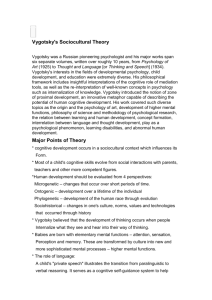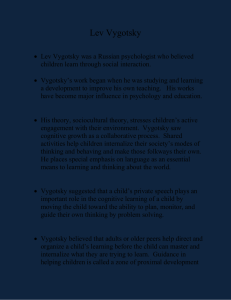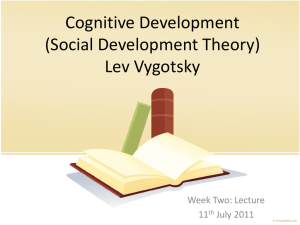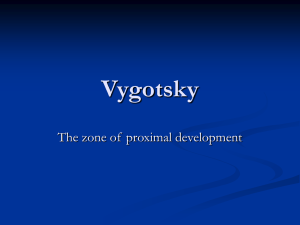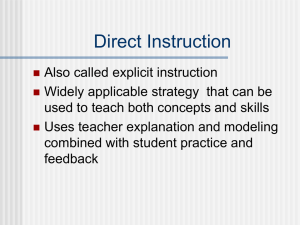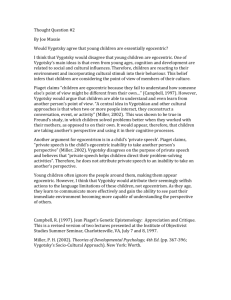12119,"private speech vygotsky",6,,,70,http://www.123helpme.com/view.asp?id=132276,3.8,142000,"2016-01-28 16:32:42"
advertisement
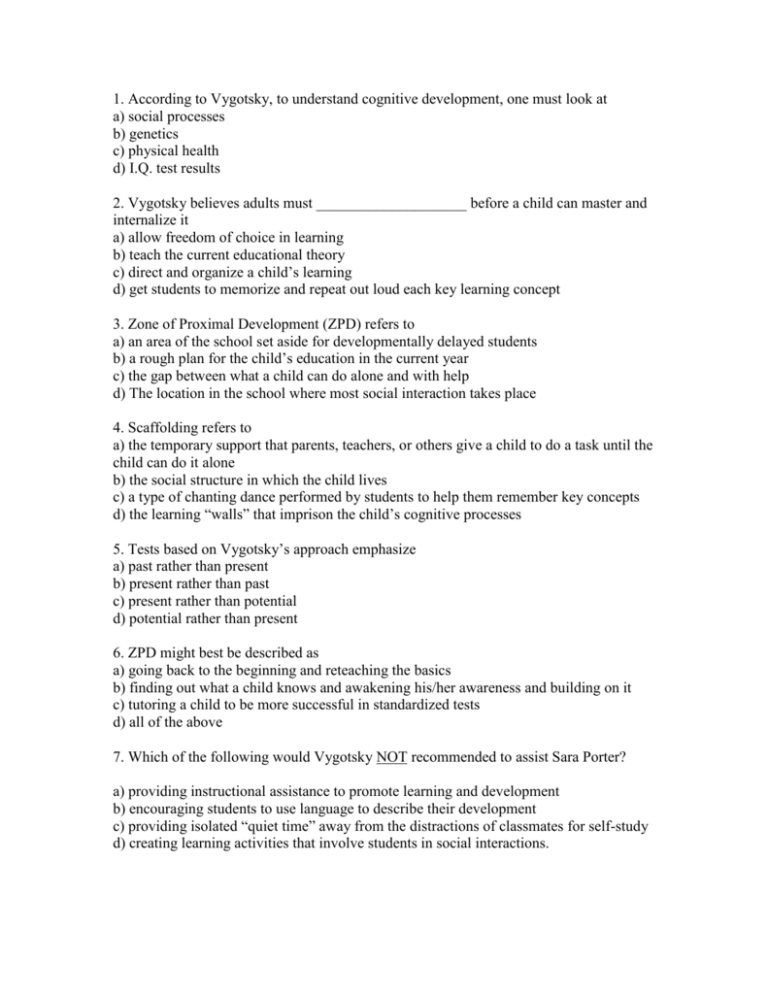
1. According to Vygotsky, to understand cognitive development, one must look at a) social processes b) genetics c) physical health d) I.Q. test results 2. Vygotsky believes adults must ____________________ before a child can master and internalize it a) allow freedom of choice in learning b) teach the current educational theory c) direct and organize a child’s learning d) get students to memorize and repeat out loud each key learning concept 3. Zone of Proximal Development (ZPD) refers to a) an area of the school set aside for developmentally delayed students b) a rough plan for the child’s education in the current year c) the gap between what a child can do alone and with help d) The location in the school where most social interaction takes place 4. Scaffolding refers to a) the temporary support that parents, teachers, or others give a child to do a task until the child can do it alone b) the social structure in which the child lives c) a type of chanting dance performed by students to help them remember key concepts d) the learning “walls” that imprison the child’s cognitive processes 5. Tests based on Vygotsky’s approach emphasize a) past rather than present b) present rather than past c) present rather than potential d) potential rather than present 6. ZPD might best be described as a) going back to the beginning and reteaching the basics b) finding out what a child knows and awakening his/her awareness and building on it c) tutoring a child to be more successful in standardized tests d) all of the above 7. Which of the following would Vygotsky NOT recommended to assist Sara Porter? a) providing instructional assistance to promote learning and development b) encouraging students to use language to describe their development c) providing isolated “quiet time” away from the distractions of classmates for self-study d) creating learning activities that involve students in social interactions. 8. Vygotsky’s Socio-Cultural Theory of Development states that ______ have an influence on cognitive development a) Culture and Language b) Language and Social Interaction c) Social Interaction and Culture d) Culture, Language, and Social Interaction 9. Vygotsky emphasizes the importance of focusing on a) The individual b) Larger interactional units c) Relationships with animals d) IQ Tests 10. According to Vygotsky, what is the ideal theoretical approach teachers should use a) Teacher-directed b) Student-directed c) Collaborative d) Freestyle Answer Key 1. a) 2. c) 3. c) 4. a) 5. d) 6. b) 7. c) 8. d) 9. b) 10. c) 1. Which of the following, would Vygotsky suggest as a teaching strategy? a) working in groups have students perform different tasks independently in a rotational order b) teachers should work with each student to offer their expertise on the subject c) more knowledgeable students in a subject area should work collaborately with others to encourage further learning d) b and c e) none of the above 2. According to Vygotsky…… a) children’s development must precede learning b) children can only learn the skills that they are developmentally ready for c) children’s learning must precede development d) children should work independently and only ask for assistance when required e) a and d 3. The Zone of Proximal Development (ZPD) is…… a) the difference between a student’s ability to work on their own or in a group b) the area between what a student achieves when they complete a task unassisted and when they complete that same task assisted c) the amount of work a student completes when they are helped by the teacher d) the potential of a student when they have assistance from an older student more knowledgeable in a certain subject area e) none of the above 4. Vygotsky’s socio cultural theory states that….. a) children construct knowledge b) learning can lead development c) development cannot be separated from its social context d) language plays a central role in mental development e) all of the above 5. If teaching according to Vygotsky’s theory, instruction should be aimed towards…… a) the higher level of the student’s Zone of Proximal Development b) the student’s level of independent performance c) the student’s zone of proximal development d) the lower level of the student’s Zone of Proximal Development e) none of the above 6. Vygotsky believed that to construct knowledge learners must… a) create their own representations of new information through collaboration with another human b) make meaning of new information only through interaction with physical objects c) memorize the new information until they can recite it thoroughly d) take the new information and make meaning that is not connected 7. _________________is a Vygotskian principle. a) understanding language is a prerequisite for learning b) scaffolding c) the zone of proximal development d) learning must involve interaction with another human being e) all of the above 8. Vygotsky said that the intellectual development of humans has evolved….. a) due to the passing down of mental tools through the generations b) because we have invented more technology to assist with processing information c) from looking back and analysing the mistakes other generations have made so not to repeat them d) due to the large amount of fantastic teachers in our school systems e) none of the above 9. According to Vygotsky, language…. a) is a mechanism for thinking b) allows us to discuss things that have happened, will happen, or might never happen c) is the means with which information is passed down from one generation to another d) is the medium that carries the experience into the mind e) all of the above 10. Vygotsky’s theory is a… a) behaviourialist theory b) constructivist theory c) capitalist theory d) conspiracy theory e) none of the above 1. Vygotsky believed important psychological tool(s) included: (a) mnemonic techiniques (b) language (c) diagrams (d) all of the above 2. Vygotsky believed that knowledge and abilities were: (a) innate (b) learned from culture around them (c) all of the above (d) none of the above 3. What is one of Ms. Mercer’s failures according to Vygotsky? (a) She does not use enough individual work (b) She does not scaffold learning (c) She has overly high expectations for grade three students (d) She has a negative attitude 4. Research shows that the zone of proximal development is greater when the learner receives guidance from: (a) the teacher (b) same age peers (c) a skilled adult (d) older peers 5. What concept would best help a child who cannot master a problem independently but can with skilful guidance? (a) tools of intellectual adaptation (b) zone of proximal development (c) social interactions (d) higher mental functions 6. Vygotsky believed that cognitive development: (a) is mostly universal across cultures (b) stems largely from independent explorations (c) varies across cultures (d) is very egocentric in nature 7. Instructed learning is accomplished primarily through: (a) visual cues (b) language (c) consequences (d) rewards 8. Children acquire their thinking and reasoning processes from: (a) their peers (b) imitative learning (c) their culture (d) collaborative learning 9. Vygotsky believed that every child has a set of ____________: (a) innate abilities (b) tools of adaptation (c) thinking and reasoning processes (d) higher mental functions 10. Vygotsky believed that psychological tools were (a) skilled peers (b) conflict resolvers (c) social interactions (d) mediators for learning 1. What is the zone of proximal development (ZPD)? (a) the physiological needs of the student must be met before learning can occur (b) cognitive development occurs in four distinct stages (c) the student’s surrounding environment (d) a student’s ability to improve their performance with assistance from a skilled member of society 2. Which of the following is not one of Vygotsky’s four levels of analysis? (a) microgenetic (b) subgenetic (c) ontogenetic (d) sociohistorical 3. Vygotsky’s cognitive development theory is based is on the following idea (a) social cognitive theory (b) behavioural theory (c) operant conditioning (d) socio-cultural theory 4. According to Vygotsky’s theory: (a) Children internalize culture’s tools that are transmitted by adults (b) Cognitive growth stems from social interactions (c) Cognitive development varies across cultures (d) All of the above 5. According to Vygotsky, acquiring knowledge for knowledge’s sake is… (a) cognitive self-guidance system (b) context independent learning (c) zone of proximal development (d) scaffolding 6. According to Vygotsky, guided participation means (a) adult-child interactions in which children’s cognitions and models of thinking are shaped as they participate (b) the use of private speech to guide problem solving behaviour (c) learning that has no immediate relevance to the present context (d) students lead each other in discovery 7. Scaffolding is the process of (a) a teacher responding contingently to the student’s behaviour in a learning situation (b) a teacher does not respond contingently to the student’s behaviour in a learning situation (c) a student responds contingently to the teachers behaviour in a learning situation (d) a student does not responds contingently to the teachers behaviour in a learning situation 8. A cognitive self-guided system relies on _________________ to guide problem solving behaviour. (a) guided participation (b) scaffolding (c) private speech (d) context-independent learning 9. Private speech serves which of the following functions: (a) guides the child’s thinking (b) serves as a self-communicative function (c) term for the subset of the child’s verbal utterances (d) all of above 10. Which of the following is not one of Vygotsky’s recommendations for teachers: (a) provide opportunities for active rather than passive learning (b) offer strategies for context independent learning (c) provide activities that allow for guided participation (d) provide time for independent problem solving Answers: 1(d) 2(b) 3(d) 4(d) 5(b) 6(a) 7(a) 8(c) 9(d) 10(d)
